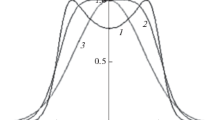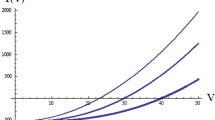Abstract
The spin-lattice relaxation times in water and NaCl aqueous solutions in a low-frequency magnetic field have been measured on natural-concentration 17O nuclei. The activation energies have been calculated. The differences in the temperature dependences of the spin-lattice relaxation time and the changes in the relaxation with the magnetic field frequency are established.
Similar content being viewed by others
References
N. A. Belova and V.A. Panchelyuga, “Lednev’s Model: Theory and Experiment,” Biophysics. 55(4), 661 (2010).
S. D. Zakharov, “On the Possible Fundamental Unity of Magnetobiological “Resonances”,” Biophysics. 55(4), 561 (2010).
A.V. Drozdov, T.P. Nagorskaya, S.V. Masyukevich, and E.S. Gorshkov, “Quantum Mechanical Aspects of the Effects of Weak Magnetic Fields on Biological Objects,” Biophysics. 55(4), 652 (2010).
D. Marx, M.E. Tuckerman, J. Hutter, and M. Parrinello, “The Nature of the Hydrated Excess Proton in Water,” Nature. 397(6720), 601 (1999).
J. T. Hynes, “Physical Chemistry: The Protean Proton in Water,” Nature. 397(6720), 565 (1999).
N. S. Vasilyev and D.V. Kashaev, “The Study of Relaxation Processes in the Water under the Influence of the Magnetic Field,” Ekologicheskii Vestnik Nauchnykh Tsentrov Chernomorskogo Ekonomicheskogo Sotrudnichestva. No. 1, 25 (2011).
Structural Self-Organization in Solutions and at Interfaces, Ed. by A.Yu. Tsivadze (Izd. LKI, Moscow, 2008), p. 217 [in Russian].
E. B. Burlakova, A.A. Konradov, and E. L. Maltseva, “Effects of Extremely Weak Chemical and Physical Stimuli on Biological Systems,” Biophysics. 49(3), 522 (2004).
T.V. Drokina and L. Yu. Popova, “Effect of Millimeter Electromagnetic Waves on Bacterial Luminescence,” Biophysics. 43(3), 492 (1998).
V. Maémets and I. Koppel, “Effect of Ions on the 170 and 1U NMR Chemical Shifts of Water,” J. Chem. Soc. Faraday Trans. 94, 3261 (1998).
V. Maémets and I. Koppel, “O and H NMR Chemical Shifts of Hydroxide and Hydronium Ion in Aqueous Solutions of Strong Electrolytes,” J. Chem. Soc. Faraday Trans. 93(8), 1539 (1997).
Author information
Authors and Affiliations
Corresponding author
About this article
Cite this article
Vasilyev, N.S., Kashaev, D.V. & Baryshev, M.G. Study of the effect of a low-frequency magnetic field on the spin-lattice relaxation in water and in aqueous solutions. Phys. Wave Phen. 19, 305–307 (2011). https://doi.org/10.3103/S1541308X1104011X
Received:
Published:
Issue Date:
DOI: https://doi.org/10.3103/S1541308X1104011X




